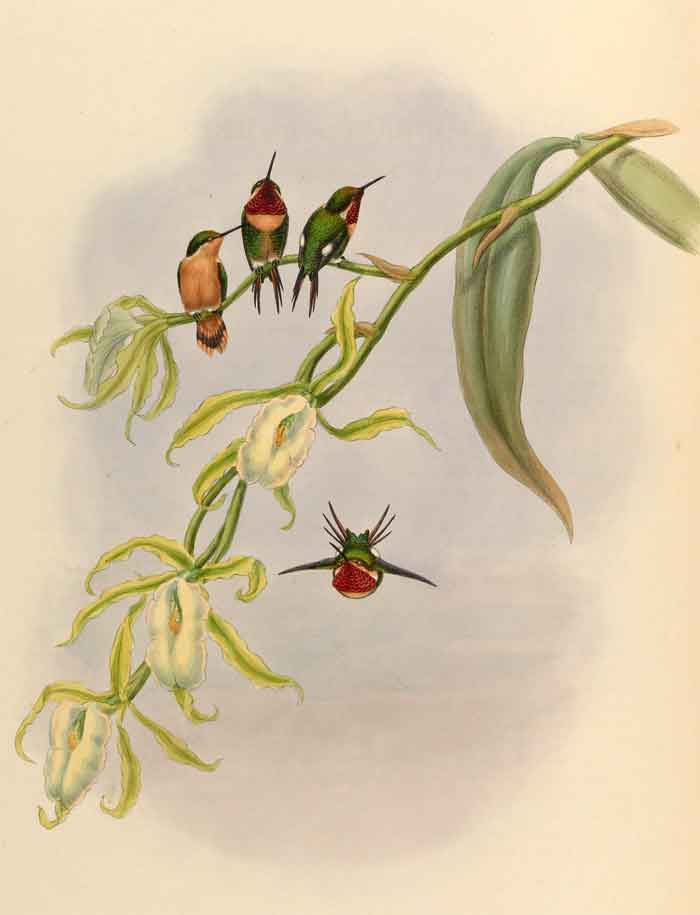
Chaetocercus bombus , Photo: Michael Lahanas
Superregnum: Eukaryota
Cladus: Unikonta
Cladus: Opisthokonta
Cladus: Holozoa
Regnum: Animalia
Subregnum: Eumetazoa
Cladus: Bilateria
Cladus: Nephrozoa
Superphylum: Deuterostomia
Phylum: Chordata
Subphylum: Vertebrata
Infraphylum: Gnathostomata
Megaclassis: Osteichthyes
Cladus: Sarcopterygii
Cladus: Rhipidistia
Cladus: Tetrapodomorpha
Cladus: Eotetrapodiformes
Cladus: Elpistostegalia
Superclassis: Tetrapoda
Cladus: Reptiliomorpha
Cladus: Amniota
Classis: Reptilia
Cladus: Eureptilia
Cladus: Romeriida
Subclassis: Diapsida
Cladus: Sauria
Infraclassis: Archosauromorpha
Cladus: Crurotarsi
Divisio: Archosauria
Cladus: Avemetatarsalia
Cladus: Ornithodira
Subtaxon: Dinosauromorpha
Cladus: Dinosauriformes
Cladus: Dracohors
Cladus: Dinosauria
Cladus: Saurischia
Cladus: Eusaurischia
Subordo: Theropoda
Cladus: Neotheropoda
Cladus: Averostra
Cladus: Tetanurae
Cladus: Avetheropoda
Cladus: Coelurosauria
Cladus: Tyrannoraptora
Cladus: Maniraptoromorpha
Cladus: Maniraptoriformes
Cladus: Maniraptora
Cladus: Pennaraptora
Cladus: Paraves
Cladus: Eumaniraptora
Cladus: Avialae
Infraclassis: Aves
Cladus: Avebrevicauda
Cladus: Pygostylia
Cladus: Ornithothoraces
Cladus: Ornithuromorpha
Cladus: Carinatae
Parvclassis: Neornithes
Cohors: Neognathae
Cladus: Neoaves
Superordo: Caprimulgimorphae
Ordo: Apodiformes
Familia: Trochilidae
Subfamilia: Trochilinae
Genus: Chaetocercus
Species: Chaetocercus bombus
Name
Chaetocercus bombus Gould, 1871
Type locality: Ecuador.
Synonyms
Acestrura bombus (Gould, 1871)
References
Gould, J. 1871. Remarks on a Collection of Humming-birds made by Mr. Buckley in Ecuador, and Description of two new Species. Proceedings of the Zoological Society of London [1870] Pt 3: p. 803–804 BHL Reference page. p. 804
Links
IUCN: Chaetocercus bombus (Near Threatened)
Vernacular names
Deutsch: Hummelelfe
English: Little Woodstar
español: Colibrí abejorro

Chaetocercus bombus
The little woodstar (Chaetocercus bombus), called estrellita chica in South America, is a Near Threatened species of hummingbird in tribe Mellisugini of subfamily Trochilinae, the "bee hummingbirds". It is found in Colombia, Ecuador and Peru.[4][5]
Taxonomy and systematics
The little woodstar and several other species in genus Chaetocercus were formerly placed in genus Acestrura but have been in their current position since the late 20th century. The species is monotypic.[3][4]
Female at Copalinga Lodge, Ecuador
Description
The little woodstar is 6 to 7 cm (2.4 to 2.8 in) long. Both sexes have a straightish black bill. The male is mostly dark bronzy blue-green. It has a buffy white line behind the eye that curves down to meet the buffy chest. Its gorget is rosy. The tail is forked and its outermost feathers are shafts with no vanes. The female is bronzy green above and mostly cinnamon below with tawny flanks and vent. The tail is rounded and tawny with a black bar near the end.[6]
Distribution and habitat
The little woodstar is found from extreme southwestern Colombia through western Ecuador into northern Peru and discontinuously in eastern Ecuador and north central Peru. It inhabits the transition zone between semi-humid and humid deciduous forest. In elevation it ranges from sea level to 2,300 m (7,500 ft) in western Ecuador and between 900 and 3,000 m (3,000 and 9,800 ft) in eastern Ecuador and Peru.[6]
Behavior
Movement
The little woodstar is presumed to be mostly sedentary but seasonal elevational movements are likely.[6]
Feeding
The little woodstar forages from near the ground to the forest's middle level, visiting a wide variety of flowering plants and trees. Little is known about its foraging strategy but it is assumed to behave like its close relative the white-bellied woodstar (C. muslant). That species does not defend feeding territories, and because of its small size and slow bumblebee-like flight is able to feed in the territories of other hummingbirds.[6]
Breeding
Nothing is known about the little woodstar's breeding phenology.[6]
Dickcissel male perched on a metal pole singing, with neck stretched and beak open.
Songs and calls
Listen to little woodstar on xeno-canto
Vocalization
What is thought to be the little woodstar's song is "a mixture of chips, twitters and buzzy notes, 'tsitsitsi..tzzeee-tzzeee..chichip'." It makes "a single dry 'chip' or doubled 'chichip'" while feeding and hovering and "a squeaky 'kswee-kswee-ti-ti-ti'" while interacting with other hummingbirds.[6]
Status
The IUCN originally assessed the little woodstar as Threatened and reclassified it as Endangered in 1994. In 2000 it was declared Vulnerable and in 2021 Near Threatened. It has a somewhat limited range and is patchily distributed in it. Its population is estimated at 5000 to 20,000 mature individuals and is believed to be decreasing. It is threatened by continuing loss of forest habitat to logging, agriculture, settlements, and mining.[1]
References
BirdLife International (2021). "Little Woodstar Chaetocercus bombus". IUCN Red List of Threatened Species. 2021: e.T22688257A181597476. doi:10.2305/IUCN.UK.2021-3.RLTS.T22688257A181597476.en. Retrieved 25 July 2022.
"Appendices | CITES". cites.org. Retrieved 2022-01-14.
Remsen, J. V., Jr., J. I. Areta, E. Bonaccorso, S. Claramunt, A. Jaramillo, D. F. Lane, J. F. Pacheco, M. B. Robbins, F. G. Stiles, and K. J. Zimmer. Version 24 July 2022. A classification of the bird species of South America. American Ornithological Society. https://www.museum.lsu.edu/~Remsen/SACCBaseline.htm retrieved July 24, 2022
Gill, F.; Donsker, D.; Rasmussen, P., eds. (January 2022). "Hummingbirds". IOC World Bird List. v 12.1. Retrieved January 15, 2022.
HBW and BirdLife International (2020) Handbook of the Birds of the World and BirdLife International digital checklist of the birds of the world Version 5. Available at: http://datazone.birdlife.org/userfiles/file/Species/Taxonomy/HBW-BirdLife_Checklist_v5_Dec20.zip [.xls zipped 1 MB] retrieved 27 May 2021
Züchner, T., E. de Juana, and P. F. D. Boesman (2020). Little Woodstar (Chaetocercus bombus), version 1.0. In Birds of the World (J. del Hoyo, A. Elliott, J. Sargatal, D. A. Christie, and E. de Juana, Editors). Cornell Lab of Ornithology, Ithaca, NY, USA. https://doi.org/10.2173/bow.litwoo5.01 retrieved July 25, 2022
Retrieved from "http://en.wikipedia.org/"
All text is available under the terms of the GNU Free Documentation License

